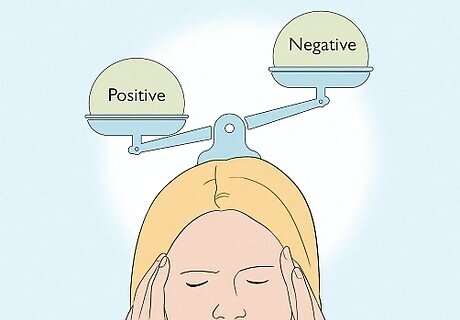
views
Becoming Aware of Your Negative Thought Patterns

Realize whether you're clinging to negatives. Have you ever had an overwhelmingly successful and productive day, but yet upon reflecting, found yourself focusing on nothing but the negatives? This is called filtering. Like a filter, your mind ‘filters’ out all of the positives and increases the significance of the negatives.

Keep a gratitude journal. This will help you identify and focus on the things that you are grateful for. Write in detail about one particular thing you are thankful for instead of creating a general list. Life coach Leah Morris even suggests looking for positive points in negative moments, like an overwhelming situation. Writing less frequently is better in achieving optimum results, so aim for writing once or twice a week. Try and focus your writing on people, and not things since focusing your gratitude on people tends to be more meaningful.

Remember that it’s not always your fault. Personalizing is another form of negative thinking. It occurs when something negative happens and you automatically assume that you are responsible for it. Instead of jumping to conclusions, become curious and ask how or what questions to gather more information. For example, you call up a friend and tell them that you plan on visiting them later that day. They respond that today wasn’t such a good day and that they will call you tomorrow to reschedule. You assume they are trying to avoid you. Instead of assuming, you could ask, “What happened for you to reschedule our visit?”

Avoid catastrophizing. Catastrophizing is irrationally predicting negative outcomes and assuming that if a negative did occur, the results would be catastrophic. One type of catastrophizing is making a catastrophe out of a non-catastrophic situation. For example, that slight burning sensation isn’t a heart attack. You just ate an extra large Philly cheesesteak with the extra onions, green peppers, and jalapenos. It’s just heartburn. Combat this type of thinking by reminding yourself, “I am causing my own suffering. Can I stop doing this?” This thought will remind you that you are responsible for creating your own worrying at the moment, and only you have the power to make it go away.

Believe in positive outcomes. Try to avoid assuming negative outcomes for future events. For example, you have an upcoming interview, and you anticipate the interview going horribly wrong despite all of your diligent preparation. Instead, life coach Leah Morris recommends telling yourself positive affirmations to get yourself pumped up. Combat this type of thinking by taking notice of when it occurs. Jot down what happened, your thoughts on what happened and how you reacted and responded. You’ll begin to notice a pattern to your thinking. You can then reverse this type of thinking by engaging in positive self-talk. For example, you wanted to make a special dinner for your significant other but instead ended up burning the meal. You find yourself thinking that your significant other is going to be angry and the evening will be ruined. Instead, tell yourself that it’s okay because everyone makes mistakes. You can simply go out to eat someplace nice.

Keep in mind that not everything is simply black or white. Polarizing is when you tend to view things outright as either good or bad. There is no room for a happy medium. Perfection is the only option. Write down your polarizing thoughts to help recognize your over dramatic thinking. When you put things in writing, it helps make your thinking more concrete and easier to analyze. For example, if you wrote down, “I missed the soccer game. I’m a horrible mother,” you might recognize that you were being too hard on yourself.
Discarding Negative Thoughts

Acknowledge your negative thoughts. It takes only about 30 seconds for a thought in your mind to enter your deep consciousness. As a result, thinking that you can simply just push it out of your mind won’t work. In fact, It takes a lot more mental energy and effort to fight against a negative thought. Acknowledging negative thinking doesn’t mean dwelling on it. Instead, you allow your mind to briefly accept that the thought has entered your mind, and then intentionally releasing the thought from your mind.

Release your negative thoughts. Use visual imagery to allow your negative thoughts to be released. For example, you might want to imagine placing your negative thought on a leaf and then watching it float down the stream.

Have concerns without dwelling on them. Sometimes you have valid reasons to be concerned or worried about something, especially when feeling like you have no control over the situation. Therefore, it’s okay to recognize that there is reason for concern. Just don’t allow them to fester in your mind. Freeing up your mind from negative thoughts makes space for other, more positive thoughts. With practice and time, you’ll notice that you’ll have a tendency to engage in more positive thinking.

Don’t buy into the negative thinking. If you begin to believe that your negative thoughts are valid, then they become your reality. Instead, ask yourself these three questions when negative thoughts take over: Are these thoughts reasonable? Are they rational? Are they reliable? If you can identify that a negative thought is unreasonable, then it allows you to put things into perspective. If you conclude that your thinking is irrational, then you can cease engaging in irrational behavior. Finally, if your negative thought is unreliable, then you can recognize that it is unlikely to be true.

Determine the source of your negative thinking. Figure out which personal experiences you’ve had that are behind your negative thoughts to gain perspective on your thinking and reasoning. You can then ask yourself what about that experience has lead to your negative perception.

Think of the worst possible outcome that could happen. This sounds both counterproductive and extreme, but it works. Why? It allows you to see things in a more realistic perspective. For example, someone who is afraid of flying might be fearful of being in a plane crash. They might imagine themselves being the sole survivor of the crash, stranded on a deserted island and being eaten alive by a pack of wolves. Imagining their greatest fear can help them realize the absurdity of their fear.
Learning to Focus on Positive Thoughts

Pinpoint specific areas plagued with negative thinking. There are probably certain areas in your life that you tend to view in a negative light. It might be your career, family, appearance, etc. If you can identify which areas you need to view more positively, you can work on improving your perspective.

Focus on improving one area at a time. Once you have identified the areas in your life where you are prone to think about negatively, give you attention to just one area. You can then give this area your full attention and avoid becoming overwhelmed.

Stay in the company of positive people. You are the company that you keep. Surround yourself with positive people, and their positivity will rub off on you. On the other hand, keeping company with negative people will turn you into a sour-puss as well. Try and connect with individuals who share some or your interests or who are already a part of your social and community groups, such as fellow church members or fellow coworkers.

Send out positive signals so you can attract positive people. Before going out to meet others, focus on conjuring up positive energy. Think about all of your positive qualities that would attract others to you, such as your compassion, sense of humor and kindness. To boost your self-confidence, say some positive affirmations to yourself. You might say something like, "I can do this." "I'm a great friend." or "I'm a kind person." Reader Poll: We asked 443 wikiHow readers about which positive affirmation works best for them, and only 8% said, “My body is strong in every way.” [Take Poll] While this mantra can still make you feel good, try reciting other phrases like “I believe in myself” or “I am enough.”

Engage in positive self-talk. Positive self-talk is about focusing your internal thoughts into all of the things that are good about you. How you talk to yourself plays a prominent role in your self perception and worldview. When you have negative thoughts, change it to a positive thought. For example, instead of thinking, “I’m no good at dancing,” tell yourself, “I will get better with practice.” If you’re negatively thinking, “I’m too tired to work,” change it to, “I will put forth my best effort even though I’m tired.” Like anything, practice makes perfect. It takes time to develop a habit, so the more you focus on engaging in positive self-talk, the more natural at it you’ll become.



















Comments
0 comment